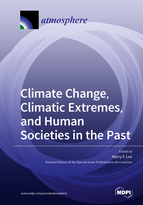Climate Change, Climatic Extremes, and Human Societies in the Past
A special issue of Atmosphere (ISSN 2073-4433). This special issue belongs to the section "Climatology".
Deadline for manuscript submissions: closed (15 March 2020) | Viewed by 26818
Special Issue Editor
Interests: socio-economic and demographic impacts of climate change in ancient and recent human history; underlying mechanisms of climatic extremes; historical epidemiology; environmental perceptions and sustainability
Special Issues, Collections and Topics in MDPI journals
Special Issue Information
Dear Colleagues,
I invite researchers, no matter whether they agree on the significant impact of climate change on human societies or whether they are skeptical about such relationship, to contribute original research articles, as well as review articles, dealing with all aspects of the climate–society nexus in ancient/recent human history. This Special Issue is going to serve as a platform for collecting different opinions and facilitating a constructive debate about the ways in which the climate–society nexus can be generalized, contextualized, or even denied—a philosophical issue pertinent to the theoretical underpinnings of environmental humanities. This Special Issue will also publish review articles that help identify possible future research directions. Topics of interest include, but are not limited to the following:
- How and to what extent human societies are (or are not) affected by climate change or climatic extremes;
- The use of big archaeological/historical data in investigating the climate–society nexus;
- The application of statistical methods in quantitatively assessing the climate–society nexus;
- The influence of spatio-temporal scale, study period, and study area on the climate–society nexus;
- Philosophical discussion about the climate–society nexus.
Prof. Harry F. Lee
Guest Editor
Manuscript Submission Information
Manuscripts should be submitted online at www.mdpi.com by registering and logging in to this website. Once you are registered, click here to go to the submission form. Manuscripts can be submitted until the deadline. All submissions that pass pre-check are peer-reviewed. Accepted papers will be published continuously in the journal (as soon as accepted) and will be listed together on the special issue website. Research articles, review articles as well as short communications are invited. For planned papers, a title and short abstract (about 100 words) can be sent to the Editorial Office for announcement on this website.
Submitted manuscripts should not have been published previously, nor be under consideration for publication elsewhere (except conference proceedings papers). All manuscripts are thoroughly refereed through a single-blind peer-review process. A guide for authors and other relevant information for submission of manuscripts is available on the Instructions for Authors page. Atmosphere is an international peer-reviewed open access monthly journal published by MDPI.
Please visit the Instructions for Authors page before submitting a manuscript. The Article Processing Charge (APC) for publication in this open access journal is 2400 CHF (Swiss Francs). Submitted papers should be well formatted and use good English. Authors may use MDPI's English editing service prior to publication or during author revisions.
Keywords
- Climate change
- Climatic extremes
- Human societies
- Adaptation to climate change
- Climate resilience
- Archaeology
- History
- Big data
- Case study






